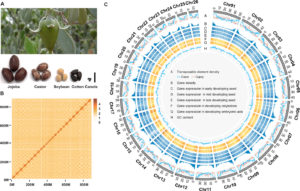The genome of jojoba (Simmondsia chinensis): A taxonomically isolated species that directs wax ester accumulation in its seeds
University of North Texas, Huazhong Agricultural University, Heinrich Heine University, University of Goettingen, Leibniz Institute of Plant Genetics & Crop Plant Research, USDA-ARS

Abstract
Seeds of the desert shrub, jojoba (Simmondsia chinensis), are an abundant, renewable source of liquid wax esters, which are valued additives in cosmetic products and industrial lubricants. Jojoba is relegated to its own taxonomic family, and there is little genetic information available to elucidate its phylogeny. Here, we report the high-quality, 887-Mb genome of jojoba assembled into 26 chromosomes with 23,490 protein-coding genes. The jojoba genome has only the whole-genome triplication (γ) shared among eudicots and no recent duplications. These genomic resources coupled with extensive transcriptome, proteome, and lipidome data helped to define heterogeneous pathways and machinery for lipid synthesis and storage, provided missing evolutionary history information for this taxonomically segregated dioecious plant species, and will support efforts to improve the agronomic properties of jojoba.
NanoESI-MS/MS and UPLC-nanoESI-MS/MS methods using the Advion TriVersa NanoMate were used to analyze triacylglycerols from jojoba.
